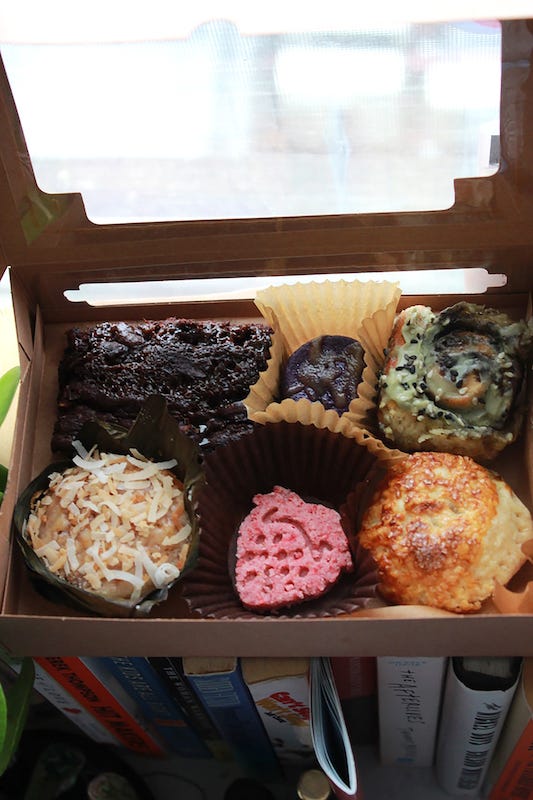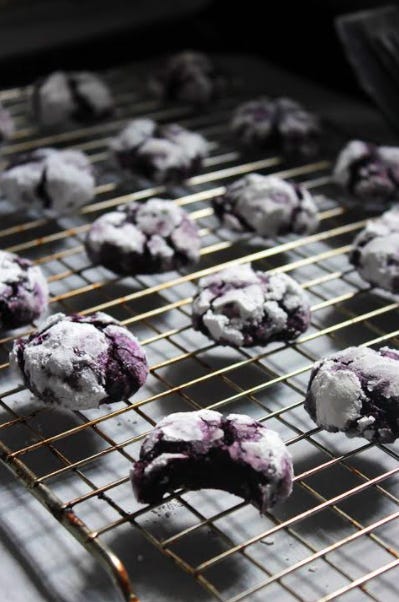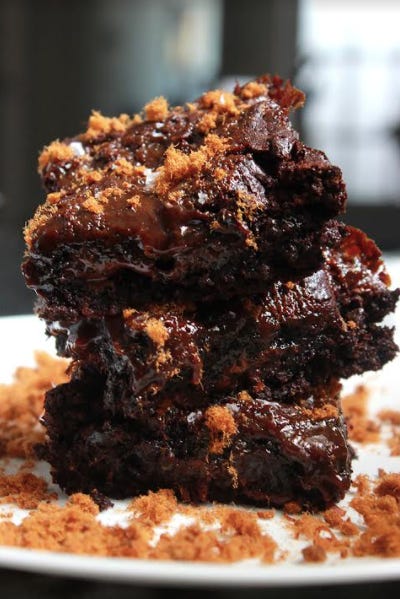Lately, I find myself craving Filipino food. This might not seem unusual for someone who is Filipino, but it’s probably the cuisine I cook the least. Not because I don’t love it, because I do, but because it’s just never as good when I make it.
Also, Filipino food doesn’t exactly lend itself to vegetarian cooking very well. A lot of (savory) Filipino dishes are made with pork or some kind of meat product, and most of my fondest food memories involve eating meat. (I’ll go into this more in next week’s newsletter.) This makes translating a lot of the dishes I know and love into meat-free versions decidedly tricky.
Despite this, I find myself yearning for dishes I used to eat back home, like tortang talong (which I talked about in my last newsletter), lumpiang togue, kare-kare, and ginataang bilo-bilo, so much so that every few weeks, I pester my mom via WhatsApp to send me recipes of whatever dish I’d been craving during the week. From those pesterings, I’ve amassed quite a collection. Although I’ve yet to make most of them, just knowing that I have access to them and can, hypothetically, make them at any time is enough to tide me over.
Though these cravings initially struck me as strange, it wasn’t until I realized the reason behind them that it all started to make sense: This is the longest I’ve gone without going home.
It’s been nine months since my last visit and it’ll probably be many more before I’m able to see my family. While this may not seem like that much time, before the pandemic, I’d managed to fit in trips to Manila at least twice to three times a year. During those trips, I’d always made it a point to get my fill of all the foods I’d been missing, and at least three trips to Cosmic, my favorite vegan Filipino restaurant, while in town. Like a lot of people around the world who’ve been forced apart from their loved ones, I miss my family, but our semi-weekly Zoom sessions have been of some comfort. The food, however, is a bit more challenging to work through.
This yearning for home has manifested in a kind of hyper-awareness, or hyper-interest, in the work of other Filipinos in the diaspora, particularly in how they’re addressing their longings and how they’re making waves in their own respective scenes. That’s how I stumbled on Abi Balingit and her baking blog The Dusky Kitchen.
Based in Brooklyn, Abi works as an ad operations manager for live music company Bands In Town. When she’s not busy with work or keeping up with Great British Bake-Off’s Nadya Hussain’s career, she’s creating Asian-inspired pastries and confections from her Bed-Stuy apartment for her blog The Dusky Kitchen. Many of her recipes feature classic Filipino flavors like ube, various kakanin, and tropical fruits, as well as other Asian flavors like miso and pork floss.
To help launch her blog, in July, Abi sold boxes of mixed pastries she affectionately named Pasalubong. Included in every treat box were strawberry polvoron, pork floss with white miso caramel brownies, ube puto with cheese, black sesame cinnamon rolls, mini peach mango pies, and horchata bibingka. Fifty percent of the proceeds went to Bed-Stuy Strong, an organization that provides assistance to Bed-Stuy residents who’ve been disproportionately affected by the pandemic.
I got in touch with Abi to talk about the blog, what it was like growing up in a house she compares to Full House, how she came up with the idea for the pasalubong boxes, and how she’s forging a deeper connection with her roots through baking.

Hi, Abi! What made you want to start the Dusky Kitchen?
For the past year, I’ve really leaned into baking after moving into my current apartment in Bed-Stuy. After much encouragement and support from my friends, I ended up dedicating a blog to baking as a way to document my progress and archive recipes that I’ve tried. Prior to the pandemic, I could only bake after commuting from my company’s old office in Manhattan. By the time I’d get to whipping a dessert up in the kitchen, it’d be dusk. And the name is also a testament to the lack of natural light in my kitchen with only one window in the common area. It wasn’t until the quarantine period that I really had time to sit down and make this blog happen. The Dusky Kitchen was born out of a need for a creative outlet and to prove something to myself that I can do anything I set my mind to.
On your blog, you say you have a love-hate relationship with baking, can you expand on what you love and hate about it specifically?
My love for baking definitely outweighs the things I hate about it, but that all comes from being a perfectionist. When I mess up and waste hours of work and precious ingredients, I feel like a failure. I’m really hard on myself when I shouldn’t be. If I’m baking a batch of cookies and they don’t turn out the way I want them to, I am initially upset but immediately pivot to ways I could improve for the next time. I’m trying to unlearn this habit of feeling angry because the troubleshooting part is the real joy in baking. There isn’t so much room for error, but when it does happen, it’s a test of a good baker to keep on going.
I also love baking because it helps me channel my creativity! Whenever I think of cool flavor combinations or see a fruit I’ve never tried before show up at the grocery store, I feel so inspired to try new recipes to incorporate them. It’s so rewarding to have something tangible and (hopefully) delicious to share with the people I love. I’ve always had a sweet tooth, and baking allows me to justify indulging in it. Instead of buying Little Debbie Cosmic Brownies, I think of ways I can make them at home. As a self-taught baker, I’m happy that there are so many opportunities to build on my techniques just by watching YouTube videos and Instagram tutorials.
You grew up in San Jose in a house you say was akin to Full House. What was that like? And what kinds of foods did you grow up eating?
For the first five years of my life, I was lucky to have grown up with so much family around. I lived in a room with my mom, dad, and two sisters. Meanwhile, the other rooms in the house were occupied by my two cousins, aunt, three uncles, and my lolo. Mind you, it wasn’t a large house by any means! We lived in close quarters and I didn’t have my own bed, but I remember it as such a happy part of my childhood. It was the quintessential first-gen immigrant experience, living in a multi-generational home. Every morning was filled with the sound of laughter and talking, and always having food on the table. I grew up eating home-cooked Filipino food like my dad’s beef nilaga and dunking pandesal in bowls of dinuguan. When my older sister and I were bored, we’d pretend that butong pakwan (dried and salted watermelon seeds) were the communion wafers you’d serve at a Catholic mass. There was never a time that I felt hungry or alone. In my narrative, I was the Michelle Tanner in this very full house.
What’s a food memory that stands out in your mind from that time?
When I was in kindergarten, my Auntie Rina would pick me up from school and we’d walk home together. My school was right across the street, but I was not allowed to walk home alone. One day, it was pouring rain and I waited outside for what felt like hours (it was probably only 30 minutes or so lol). I was crying and eventually, a woman I didn’t know came by to ask me if I had a way to get home. In hindsight, this was not the best idea to go home with a stranger. But she walked me to my front door, and Auntie Rina opened it. She was horrified and so distressed to find her niece soaking wet. She thanked the stranger, and she apologized to me so many times. She forgot to pick me up because she was frying ukoy! Ukoy is a Filipino shrimp fritter that tastes delicious dipped in garlic vinegar. I remember walking into the house and smelling the oil she was frying the ukoy in. I was so relieved that she didn’t leave me there without any good reason at all. And to this day, we talk about that rainy afternoon mishap and laugh.

How did you come up with the idea for the pasalubong boxes and how did you choose the items to include in it?
I came up with the idea of the Pasalubong treat boxes with lots of inspiration from Bakers Against Racism, and the idea of just giving back to the community with whatever skills you have. In my case, I knew I could bake and it was encouraging to see peers in NY making concerted efforts to do the same. I followed Bed-Stuy Strong’s efforts in feeding neighbors across Brooklyn with grocery deliveries to those most vulnerable to COVID-19, and knew immediately that I wanted to help. I brainstormed a variety of treats that reminded me of home and came up with six different desserts that had Filipino and Asian influences. I like to think that the treat boxes reflected the diverse flavors I grew up with and hope that others appreciated them too.
What’s your favorite kakanin (traditional Filipino treats usually made from rice [kanin in Filipino] flour) and Filipino dessert?
Choosing my favorite kakanin is so hard! From colorful sapin-sapin to sticky biko, these desserts all have a special place in my heart. However, my favorite kakanin is kutsinta, which is a brown sugar steamed rice cake usually topped with grated coconut. There’s something so addictive about the chewiness of each kutsinta, and I find myself picking them off a party platter first. My mom never made kutsinta at home since she was afraid of using lye that you use to prepare it, so I came to really appreciate the family parties where I could get my fix of kutsinta bought from Valerio’s. My all-time favorite Filipino dessert is buko pandan. The taste of young coconut with nata de coco and green gulaman reminds me of summer! It's so refreshing and indulgent. Unpopular opinion, but I love it even more than halo-halo.
How do you decide what recipes to feature on the blog?
For now, I’ve been really focused on providing the Filipino and Asian-fusion recipes from the treat boxes so that people can make the desserts at home! Over the course of this pandemic, I’ve had so much time to bake that I have a whole backlog of 30+ recipes that I have yet to post on the blog. These recipes aren’t all Filipino and some are quite American, but I'm excited to keep featuring baked goods. One day, I might expand to showcasing savory cooking recipes but I like having a dedicated space for my first love which is baking.

Do you cook a lot of Filipino food at home? What other foods are you into?
Since quarantine started, I’ve been cooking a ton of Filipino food. It’s helped that I’ve started ordering online for specific Asian ingredients and produce to be able to cook my favorite dishes. I really recommend ordering from Southeast Asian Food Group and Asian Veggies for delivery in the NY area. With the right ingredients and support from my parents on FaceTime, I’ve been able to cook kare-kare, sinigang, pinakbet, and more.
I’m really into trying my hand at experimenting with other cuisines as well! A couple months ago, I made a spread inspired by what my family would order at Zankou Chicken. Zankou is a popular Persian and Mediterranean fast-casual chain in LA. For the dinner I cooked, I made chicken shawarma, pita bread, hummus, toum, tabouleh, and pickled turnips. I was so proud of that meal! If I’m not cooking, I try to support local restaurants in the neighborhood. There’s Pilar, which is a Cuban spot not far from my apartment that I love, and also Greenberg’s Bagels where they make my go-to BEC.
What’s your relationship with the Philippines like?
I was born and raised in America, but my parents didn’t emigrate from the Philippines to the States until they were in their 30s. While I was growing up, my biggest connection to my Filipino heritage and culture was loving the food. I visited Pampanga once in 2000, and it was there that I met so many more of my relatives. I was so young at the time that I don’t think I got to fully appreciate it. It wasn’t until I went to college and got involved in the Filipino community that I embraced my roots more. I wanted to learn more about Philippine culture and history and even took a Tagalog course for a semester (unfortunately, I’m still not fluent but I can understand both Tagalog and Kapampangan). I recently was able to go back to the Philippines earlier this year in January for my cousin’s wedding, and I can’t believe it was 20 years since the first time I went back. This year, I finally got to connect with my family more and ask them questions about socio-political issues like why do people support Duterte and how the government treats the Aeta.
My relationship with the Philippines is a complicated one. As a Fil-Am, I recognize that my experiences are so different from my family still living in the Philippines. There are multiple instances where I feel like the Filipino part of my identity has been invalidated for just being born in the US. I have grown up with so much privilege as an American citizen, and I have grown to hate the havoc this country has wrought on the motherland. I love the Philippines and want to do more on educating myself on its history and helping people there dealing with poverty, corruption, and increasing infringements on their democracy by the Anti-Terror Law. If there was one word to describe my feelings towards the Philippines, it’s yearning. I yearn to know what it would have been like if the Philippines was allowed to exist as its own country unhindered by Spanish and American colonization. And what it would have been like to live there instead of here sometimes.
Do you think this project, in some ways, is your way of addressing that yearning, to try and forge a deeper connection with the homeland?
I do think that this blog has helped me forge a deeper connection with the homeland, and even more so, helped me build a bridge with other members of the Filipino diaspora. Whenever someone comments on a recipe that reminds them of what they ate as a kid with their own Filipino parents, it brings me a lot of joy. There’s this quote by José Rizal that’s been translated loosely to “No history, no self. Know history, know self.” I’ve found solace in knowing that I’m not alone. And that there are people in the same boat as me who want to make more food of their culture as a way to learn more about themselves.
Do you think Filipino food deserves more recognition in food media or do you think it’s adequately represented?
Filipino food has been getting increasing recognition across the country over the years. However, I still think there is a lot of work that needs to be done to represent it better in food media. While a western palate seems to still dictate what is top-tier food, I think treating Filipino food as a monolith isn’t an accurate depiction of the breadth of dishes you can find in different provinces. Filipino food is inherently unique and I love Alexandra Cuerdo’s documentary film Ulam: Main Dish that talks about Filipino food being on the rise in the US. One day, I hope the conversation drives further to say that Filipino food is here to stay and is constantly evolving. And it not only deserves a seat at the table but needs more Filipino voices in food media to give it the recognition it deserves.

Finally, what are your future plans for the blog?
I hope I can continue to share more recipes and that it brings more awareness to Filipino desserts. If it becomes a platform where I can have a dialogue and connect with other creatives, I would be so happy. Connecting an online community far greater than the reaches of my kitchen is something that I want to do more of with this blog.
Check out Abi’s blog The Dusky Kitchen and follow her on Instagram.
If you liked this, please consider sharing it with friends. And as always, thanks for reading!


